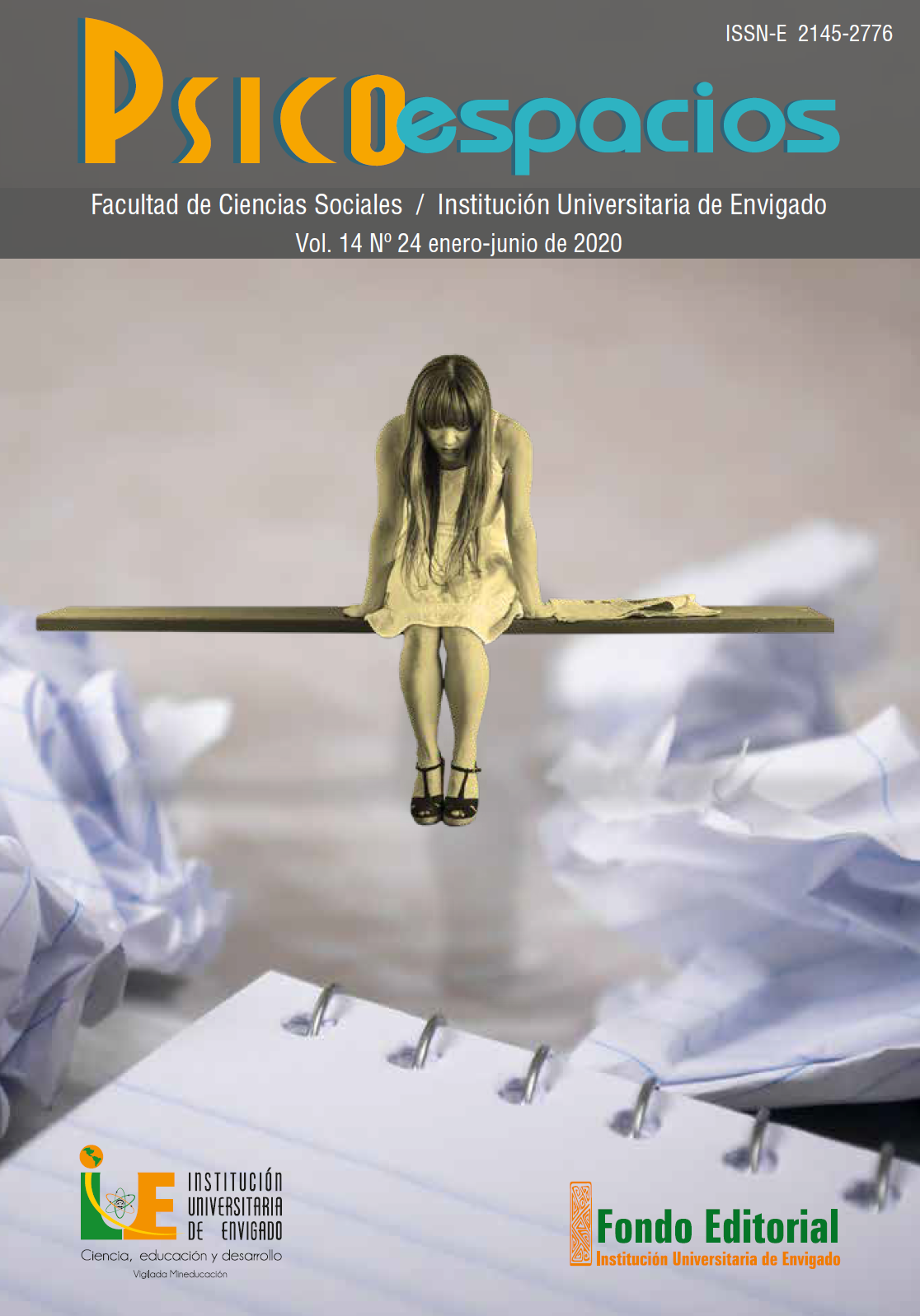Social perceptions about the phenomenon of Venezuelan migration in a sample of the inhabitants of the city of Sincelejo, Sucre, 2019
DOI:
https://doi.org/10.25057/21452776.1338Keywords:
venezuelan migration, social perceptions, xenophobia, acculturation, life habitsAbstract
Introduction: The phenomenon of Venezuelan migration has had an impact in different spheres on the Colombian population, often producing attitudes of rejection and discrimination towards the migrant population by the native inhabitants.
Objective: to describe the social perceptions of the inhabitants of the city of Sincelejo regarding the phenomenon of Venezuelan migration during the year 2019.
Method: it was the non-experimental, descriptive level study, with the sample of 100 habitants of Sincelejo, the selection of the sample was carried out randomly through the survey carried out in the streets of the city. Was used a questionnaire designed ad hoc for the present study, validity by expert judgment and pilot test, obtaining a Cronbach alpha of .83.
Results: A high score was observed in the subscale of infidelity, which reveals a negative and guilty stance regarding the problems in the love relationships of the inhabitants surveyed, perceived from the presence of Venezuelan migrant women, being this more pronounced in the participants with the lowest educational levels and socioeconomic strata. High scores on the subscale of citizen security (higher perception of threat in the higher socioeconomic strata), public order (higher perception of threat in the lower strata) and employment opportunity (higher perception of threat in higher educational levels). high), indicate the inhabitants surveyed perceive migrants as a threat to their community in these aspects. Likewise, medium high scores were found in xenophobia, with the male gender obtaining higher scores compared to the female, as well as participants with a lower educational level. Medium high levels were also found in the rejection of the cultural habits of migrants and the tendency to dominate the foreign culture by force, which does not allow the peaceful integration of migrants to the receiving community.
Conclusions: The study revealed a very worrying situation regarding the highly negative attitude observed in the study participants towards Venezuelan migrants. It is recommended to continue in this line of research in other populations in order to search for approach strategies to reduce the negative impact of these social perceptions on the migrant population and enable a better and more inclusive integration of these in the receiving communities.
Author Biographies
Olena Klimenko, Institución Universitaria de Envigado
Stefanya Peláez, Fundación Universitaria Claretiana
Laura Pacheco, Fundación Universitaria Claretiana
Yuranys Ríos Paternina, Fundación Universitaria Claretiana
References
ACNUR (La Agencia de la ONU para los refugiados) (2017). Tendencias globales, Desplazamiento forzado en 2017. https://www.acnur.org/5b2956a04.pdf
Alvarez, P., Carrasco, M., y Fustos, J. (2010). Relación de la empatía y género en la conducta prosocial y agresiva, en adolescentes de distintos tipos de establecimientos educacionales. Revista Iberoameicana de psicología: Ciencia y tecnología, 3(2), 27-36. https://doi.org/10.33881/2027-1786.rip.3203
Bermúdez, Y., Mazuera-Arias, R., Albornoz-Arias, N., Morffe, M. (2018). Informe sobre la movilidad humana venezolana. Realidades y perspectivas de quienes emigran. Venezuela: Servicio Jesuita a Refugiados. https://drive.google.com/file/d/11OMtNWuHeWjb3ykaerahBFPOBSvdsx5F/view
Berry, J. (2001). A psychology of immigration. Journal of Social Issues, 57(3), 615-631. https://doi.org/10.1111/0022-4537.00231
Cea D'Ancona, M. (2005). La exteriorización de la xenofobia. Revista Española de Investigaciones Sociológicas, 112, 197-230, http://www.reis.cis.es/REIS/jsp/REIS.jsp?opcion=articulo&ktitulo=2015&autor=M.%AA+%C1NGELES+CEA+D%27ANCONA
Consejo Nacional de Población, México (2010). Índices de intensidad migratoria México-Estados Unidos 2010. http://www.conapo.gob.mx/work/models/CONAPO/intensidad_migratoria/pdf/Efectos.pd
Departamento de Asuntos Económicos y Sociales (DAES, ONU). (2016). International Migration Report, 2015. https://www.un.org/en/development/desa/population/migration/publications/migrationreport/docs/MigrationReport2015_Highlights.pdf
Díez-Nicolás, J., y Ramírez, M. (2001). Inmigración en España, Una década de investigaciones. Madrid: IMSERSO
El Espectador (01 de Agosto de 2019). Migrantes venezolanos en Colombia según migración colombiana. https://www.elespectador.com/noticias/el-mundo/hay-1408055-migrantes-venezolanos-en-colombia-segun-migracion-colombia-articulo-873955
IOE (2003). Inmigración y Ciudadanía: España en el contexto de las migraciones internacionales. Madrid: Fundamentos.
Jackson, J., Brown, K., Brown, N., y Marks, B. (2001). Contemporary immigration policy orientations among dominant-group members in Western Europe. Journal of Social Issues, 57 (3), 431-456. https://doi.org/10.1111/0022-4537.00222
González, M. (2011). Los efectos de las migraciones internacionales en el contexto de la globalización. En F. J. García Castaño y N. Kressova. (Coords.). Actas del I Congreso Internacional sobre Migraciones en Andalucía (pp. 2033-2040). Granada: Instituto de Migraciones. https://dialnet.unirioja.es/servlet/articulo?codigo=4050052
Organización Internacional para las migraciones (OIM) (2010). Informe sobre las Migraciones en el mundo 2010. https://publications.iom.int/system/files/pdf/wmr_2010_spanish.pdf
Organización Internacional para las migraciones (OIM) (2018). Informe sobre las Migraciones en el mundo 2018. https://publications.iom.int/system/files/pdf/wmr_2018_sp.pdf
Madriz, E. (2001). A las niñas buenas no les pasa nada malo. México: Siglo XXI.
Malax, A., Díez, L., Rivero, p., Santamaría, C. (2019). Sí, pero no aquí, percepciones de xenofobia y discriminación hacia migrantes de Venezuela en Colombia, Ecuador y Perú. Informe de investigación de OXFAM, https://oxfamilibrary.openrepository.com/bitstream/handle/10546/620890/bp-si-pero-no-aqui-251019-es.pdf?sequence=8&isAllowed=y
Ministerio y salud y protección social. (s.f.). Plan de respuesta del sector de salud al fenómeno migratorio. https://www.minsalud.gov.co/sites/rid/Lists/BibliotecaDigital/RIDE/DE/COM/plan-respuesta-salud-migrantes.pdf
Navas, L., y Sánchez, A. (2009). Actitudes hacia la inmigración de los estudiantes de psicología chilenos: análisis diferenciales. SUMMA Psicológica, 6 (2), 119 – 130, https://doi.org/10.18774/summa-vol6.num2-67
Lara, A. (2007). Migraciones internacionales, seguridad y xenofobia: los límites del modelo francés de integración. Oasis. 12, 209-227, https://revistas.uexternado.edu.co/index.php/oasis/article/view/2419
Páez, D., Fernández, I., Ubillos, S., y Zubieta, E. (2004). Psicología Social, Cultura y Educación. Madrid: Ed. Pearson Educación.
Pain, R. (1995). Elderly women and fear of violent crime: The least likely victims?: A reconstruction of the extent and nature of risk. British Journal of Criminology 35 (4), 584–598, https://doi.org/10.1093/oxfordjournals.bjc.a048548
Solé, C. Parella, S., Alarcón, A., Bergalli, V. (2001). El impacto de la inmigración en la sociedad receptora. Reis, 90(7), 131-157, http://www.reis.cis.es/REIS/PDF/REIS_090_07.pdf
Suárez, D. (2008). Causas y efectos de la migración internacional. Perspectivas, (22), 161-180, https://www.redalyc.org/articulo.oa?id=4259/425942158006
Ramos De Olivera, D., Techio, E. M., Paez, D., y Herranz, C. (2005). Factores predictores de las actitudes ante la inmigración. Revista de Psicología Social 20(1):19-37, https://doi.org/10.1174/0213474052871060
Ripoll, S., Navas-Alemán, L., Arias, M., Larsen, D., Vasquez, J., Cordero, B., Ruiz, E., Manzano, D., Vasquez, G., Tamayo, C., Delgado, A., Salazar, R., Rapido, I., Zepeda, B., Mouly, C., Córdova, D., Texido, I., Sánchez, C. (2018). Xenofobia y discriminación hacia refugiados y migrantes venezolanos en Ecuador y lecciones aprendidas para la promoción de la inclusión social. Social Science in Humanitarian Action plataform, https://www.socialscienceinaction.org/
Velarde, M. (2019). Representación mediática de la dicotomía xenofobia-endofobia de la migración venezolana en el Perú del año 2017 al 2018. Tesis de grado Académico de Bachiller en Comunicaciones. Universidad San Ignacio de Loyola, http://repositorio.usil.edu.pe/bitstream/USIL/9179/1/2019_Velarde-Ramirez.pdf
How to Cite
Downloads
Languages:
esDownloads
Published
Issue
Section
License
Copyright (c) 2020 Psicoespacios

This work is licensed under a Creative Commons Attribution-NonCommercial-ShareAlike 4.0 International License.

| Article metrics | |
|---|---|
| Abstract views | |
| Galley vies | |
| PDF Views | |
| HTML views | |
| Other views | |




